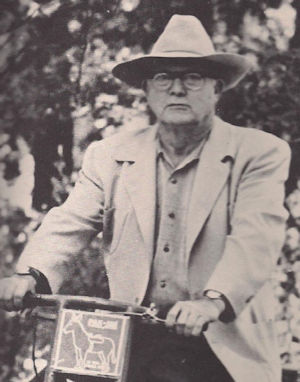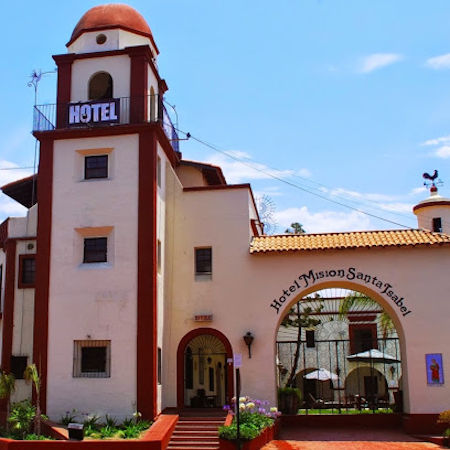 |  |
By Greg Niemann

The Jesuit Order of the Catholic Church had for over 70 years defied incredible physical odds in establishing a foothold in forbidding Baja California. Wielding great power, they had with the help of soldiers and Indians, established 18 missions in the southern half of the peninsula.
But the power appeared to be their downfall as it inspired jealousies and wild stories, real or imagined, about how their main agenda was not to save souls but to acquire wealth.
José de Gálvez, who was sent by Spain's King Charles II to colonize Alta California, especially distrusted the Jesuits. He was convinced that they had “mismanaged potentially rich missions, or used them and the people as bases and tools to secretly hoard great wealth of pearls, gold and silver.”
Stories emerged in Europe including one in which a chest of pearls, corals and precious stones was shipped by the Jesuit padres in California to a Venetian merchant in Cadiz, Spain. This story made it to the court in Madrid. Rumors began that the Jesuits had vast treasures in that land called California.
The King obviously believed enough of the stories and decided to show the Jesuits just who was really boss. In 1768, he expelled the Jesuit Order from all the Provinces of New Spain. And this broad expulsion from the Americas set the stage for the Legend of the Lost Mission.
Allegedly the Jesuits hastily established one last mission, called Santa Isabel, and this is where they hid all their accumulated wealth. One legend has it that shortly after the last Jesuit mission of Santa Maria was established, the padres received a confidential message from their superiors in Rome about the impending expulsion. They were instructed to submit peacefully but to leave no trace of their wealth.
Did they hide this wealth?

So according to folklore, the Jesuits collected the treasure of gold, silver, pearls and valuable objects from all the missions and transported it by burro to a deep gorge in the mountains some distance beyond Santa Maria where they founded the Mission Santa Isabel. When the order for their expulsion arrived, they closed off the entrance to the gorge by means of a landslide before submitting to the authorities at Loreto.
Other legends say it was at the site of a working gold mine that the Jesuits had kept secret. There were enough enticing stories to keep the gold fever alive.
One old Indian who helped out at the Mission San Borja farther to the south of Santa Maria, himself a great-grandson of a mission Indian who served under Jesuit Padre Wenceslao Link, told a story about Indians seeing golden objects in a nearby cave. He went on to describe how his ancestors had seen mule trains arriving from all the far-flung missions, their saddlebags laden with candelabra of gold and silver inset with precious stones, and other sacred vessels valued by the padres.
He then indicated that the booty was carefully hidden in a cave and a Mass was held. Shortly thereafter a rockslide sealed the entrance and because all the cliffs look so similar no one has ever been able to find it.
A 1955 expedition from New York arrived at a white limestone cliff and their metal detectors allegedly went crazy. They found an ancient compass, hundreds of years old. Directly above was a small cave with painted rock art of deer and mountain lions. They found no gold and decided to pursue it further on another later trip. Later they found the cave had been dynamited, leading them to speculate that they had been followed and perhaps their pursuers had found the lost gold.
Mystery writer Erle Stanley Gardner spent vast sums of money and launched several expeditions resulting in books searching for the Mission Santa Isabel. Some felt he searched too far to the north.
The efforts of Gaston Flourie
Perhaps the most dogged and persistent searcher of the lost Mission Santa Isabel was Gaston Eugenio Rene Flourie Sablaroles, who came to Baja California from France in 1924 at the age of 23. Flourie became a chemist engineer for the El Boleo Company at Santa Rosalia and during the 1930s enjoyed going out on desert forays searching for gold.
He became enamored with the story of the Lost Mission and spent much of his life looking for it. On an exploration in 1950 he discovered an old artesian well once used by the Jesuits – but no lost mission.

He moved to Ensenada and founded his own Mission Santa Isabel in 1951, the name he gave his new hotel at Blvd. Lazaro Cardenas and Ave. Castillo. Naturally, he designed it in Mission style and at one time the stately bell tower was a town landmark. His children still run the hotel.
But the hotel business didn't slake Flourie’s craving for the treasure of the Lost Mission of Santa Isabel. In 1952, he undertook another trip, accompanied by guide Felipe Ortega from San Felipe, Mr. Charles B. Berry and Serge D’Blanc and a writer and photographer for National Geographic magazine. They found hidden waterholes (tinajas), Indian petroglyphs and some arrowheads, but no treasure.
In 1954, Flourie was part of another major expedition to find the lost mission. He accompanied intrepid explorers Dana and Ginger Lamb of Corona del Mar, California on a search. The Lambs had achieved fame romping around southern Mexico and Central America searching for lost Mayan cities. The Baja party with Flourie went into a wide area south of Matomi Canyon in the southern San Pedro Martír mountain range. Using planes, trucks and mules, and guided by Don Santiago Espinosa, according to the Los Angeles Times all they found on that journey were more Indian petroglyphs.
They keep searching for the Lost Mission
In 1967, a search party found their quarry, the lost president of the Mountain Climbers Association of California. He claimed that in his wanderings he found a canyon with seven palms above which on the cliff was a rock slide that responded to his metal detector. His rescuers themselves made numerous trips back in search of the elusive seven palms and the lost treasure of Santa Isabel. They never found it.

There was a scientific expedition in 1975 conducted by Boston University which also involved Flourie. They were also looking for any Jesuit books and papers as well as the treasure and found zip.
Unfortunately, the legend of the Lost Mission of Santa Isabel has not been confirmed by history. There were pearls in the La Paz area and some gold and silver to be found in Baja California but most authorities note that the Jesuits were too busy trying to save the souls of the indigenous people they considered “heathens” to be bothered about collecting such a treasure. Plus they had to devote far too much time just producing food for themselves and the Indians to really care about any treasure.
However, the legend persists even to this day and many expeditions have spent considerable time searching for it. Some say it should be in a steep canyon off the eastern escarpment of the San Pedro Martír. Others put it farther south, around Laguna Chapala, and others farther north in one of the barren ranges near the gulf.
Hey, if you want to say you've been there, just go and check in at the Ensenada hotel called the Hotel Santa Isabel. It appears the only treasure realized by the hotel’s founder is the tourist income.
About Greg
Greg Niemann, a long-time Baja writer, is the author of Baja Fever, Baja Legends, Palm Springs Legends, Las Vegas Legends, and Big Brown: The Untold Story of UPS. Visit Greg's website.

Easy and affordable.

I'm listening to the audiobook of God and Mr. Gomez at this very minute. One of my favorite books....

Easiest method of getting Mexican auto insurance. Best rate we found and was setup in no time.